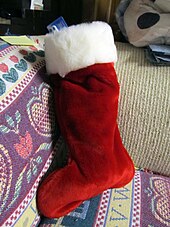
A Christmas stocking is an empty sock or sock-shaped bag that is hung on Saint Nicholas Day or Christmas Eve so that Saint Nicholas (or the related figures of Santa Claus and Father Christmas) can fill it with small toys, candy, fruit, coins or other small gifts when he arrives. These small items are often referred to as stocking stuffers or stocking fillers. The tradition of the Christmas stocking is thought to originate from the life of Saint Nicholas. In some Christmas stories, the contents of the Christmas stocking are the only toys the child receives at Christmas from Santa Claus; in other stories (and in tradition), some presents are also wrapped up in wrapping paper and placed under the Christmas tree. Tradition in Western culture threatens that a child who behaves badly during the year will receive only a piece or pile of coal. Some people even put their Christmas stocking by their bedposts so Santa Claus can fill it by the bed while they sleep.
History

Christmas stockings were mentioned as an established American tradition as early as 1823 in the poem "A Visit from St. Nicholas". The origin of the Christmas stocking is thought to originate in the life of Saint Nicholas. While there are no written records of the origin of the Christmas stocking, there are popular legends that attempt to tell the history of the Christmas tradition. One such legend has several variations, but the following is a good example: Saint Nicholas was staying with a poor family and heard that the father was planning to sell his three daughters into prostitution to save them all from starvation. Saint Nicholas wanted to help but knew that the old man would not accept charity, so he decided to help in secret. When he left the house after dark he threw three bags of gold through an open window; one landed in a stocking. When the girls and their father woke up the next morning they found the bags of gold and were, of course, overjoyed. The girls were saved from their sad fate. Other versions of the story say that Saint Nicholas threw the three bags of gold directly into the stockings, which were hung by the fireplace to dry.
This led to the custom of children hanging stockings or putting out shoes, eagerly awaiting gifts from Saint Nicholas. Sometimes the story is told with gold balls instead of bags of gold; this variation is why three gold balls, sometimes represented as oranges, are one of the symbols for Saint Nicholas. This is also the origin of three gold balls being used as a symbol for pawnbrokers.
A tradition that began in a European country originally, children simply used one of their everyday socks, but eventually special Christmas stockings were created for this purpose. These stockings are traditionally used on Saint Nicholas Day although in the early 1800s, they also came to be used on Christmas Eve.
An unsubstantiated claim is that the Christmas stocking custom derived from the Germanic/Scandinavian figure Odin. According to Phyllis Siefker, children would place their boots, filled with carrots, straw, or sugar, near the chimney for Odin's flying horse, Sleipnir, to eat. Odin would reward those children for their kindness by replacing Sleipnir's food with gifts or candy. This practice, she claims, survived in Germany, Belgium and the Netherlands after the adoption of Christianity and became associated with Saint Nicholas as a result of the process of Christianization. This claim is doubtful as there are no records of stocking-filling practices related to Odin until there is a merging of Saint Nicholas with Odin. Saint Nicholas had an earlier merging with the Grandmother cult in Bari, Italy, where the grandmother would put gifts in stockings. This merged Saint Nicholas would later travel north and merge with the Odin cults.
Present day

Today, stores carry a large variety of styles and sizes of Christmas stockings, and Christmas stockings are also a popular homemade craft. Many families create their own Christmas stockings with each family member's name applied to the stocking so that Santa will know which stocking belongs to which family member.
See also
References
- ^ Armah, Daniel A. (1 November 2011). Lessons of Christmas. Xulon Press. p. 228. ISBN 978-1619048973. Retrieved 25 December 2017 – via Google Books.
- ^ Dixon, Jeremy (5 December 2016). "Top 10 Christmas traditions and their origins". The Telegraph.
Leaving stockings out at Christmas goes back to the legend of St Nicholas. Known as the gift giver, on one occasion he sent bags of gold down a chimney at the home of a poor man who had no dowry for his unmarried daughters. The gold fell into stockings left hanging to dry. St Nicholas was later referred to by the Dutch as Sinterklaas and eventually, by English-speakers, as Santa Claus.
- Collins, Ace (2010). Stories Behind the Great Traditions of Christmas. Zondervan. p. 177. ISBN 978-0310873884.
- ^ Morris, Desmond (1992). Christmas Watching. Jonathan Cape. pp. 14–15. ISBN 0224035983.
- ^ Bowler, Gerry (2000). The World Encyclopedia of Christmas. Toronto: McClelland & Stewart. p. 156. ISBN 0771015313.
- "Three Impoverished Maidens". St. Nicholas Center. Retrieved 2013-11-17.
- Osborne, Rick (2012). Legend of the Christmas Stocking. HarperCollins. ISBN 978-0310737391.
- Siefker, Phyllis. Santa Claus, Last of the Wild Men: The Origins and Evolution of Saint Nicholas, Spanning 50,000 Years (chap. 9, esp. 171–173) (2006) ISBN 0786429585